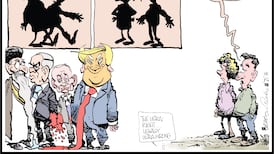Now that the Dáil has thrown its weight behind the Government's decision to support International Airlines Group's bid for Aer Lingus, the door has been kicked open for IAG to proceed with its bid to take over the former national carrier. After Thursday's vote, there will be very little left for the Government to do, as IAG shareholders' interests begin to overtake Irish interests.
For Impact, the largest union at Aer Lingus, we face a mounting challenge to secure the jobs and pay for existing and future staff. Too many questions remain about what management will look to extract from its workforce when the inevitable restructuring phase commences under new ownership.
Events this week have not come as a surprise to staff or unions at the airline: it was clear from the high level of media anticipation in recent weeks that the Government’s approval was imminent.
IAG chief executive Willie Walsh held his press conference on Wednesday against an almost carnival-like atmosphere, while stakeholder groups and Government TDs lined up to express their approval of this newly-arrived era of opportunity.
IAG’s bid is an opportunity for the company’s shareholders to acquire a valuable piece of aviation real estate, along with a valuable transport hub, highly-prized landing slots in one of the world’s busiest airports, a couple of regional hubs with huge potential, considerable cash assets, a globally recognised brand and the skills and experience of 4,000 staff who are among the best brand ambassadors in aviation.
The Government’s backing also presents an opportunity to retrieve some cash and divest itself of its share of the carrier whose fate, it will continue to argue, was sealed when 75 per cent of the airline was privatised nine years ago.
Staff concerns
But behind the talk of a new dawn for Aer Lingus there remains one stakeholder group that has not been invited to share in IAG’s joyous new age. For Aer Lingus staff, concerns about compulsory redundancies, the prospect of a further erosion of terms and conditions and the fallout from restructuring under IAG all remain.
This is despite the fact that Aer Lingus staff have been instrumental in returning the company to profitability, making it an irresistible acquisition for IAG.
The Government will argue that their concerns have been addressed by the letters of comfort sent by Aer Lingus chief executive Stephen Kavanagh to the Government this week. But the soothing words in those letters were designed merely to keep alive the prospect of a deal with the Government. In that regard, they've achieved their objective. IAG can now turn its attention to working on the other major shareholder, Ryanair.
Efficiencies
But the written assurances against compulsory redundancies and outsourcing are contingent upon achieving “efficiencies” the employer will look to extract from Aer Lingus staff. In other words, the employer is saying staff have a choice between their jobs or a further erosion of their terms and conditions. This is how IAG will begin the process of extracting a return on its investment.
To prepare for this possibility, three months ago unions sought a number of commitments in the event that a bid by IAG was successful. Neither company has made any attempt to address our questions.
This is unsurprising: it has long been our experience that Aer Lingus management will defer any engagement with unions until it becomes absolutely necessary. That usually means the threat of industrial action (as a last resort) or the intervention of a third party.
What we will need to do now is to use the system of registered employment agreements (REAs), legislation for which is due by the middle of the year. Our approach will be to have the commitments we sought built into a future REA, which will be legally binding. We have no doubt IAG will seek to avoid having their newly- acquired asset bound by such an agreement, so nobody is underestimating the scale of the challenge.
It is worth considering the contrasting fortunes of those Aer Lingus “backroom” workers whose functions will be transposed to IAG’s London headquarters, against those of Aer Lingus’s management team who are set for a major windfall. One group will walk out with modest redundancy payments, the others are set to become wealthy.
In that sense it all comes back to opportunities. For IAG shareholders and Aer Lingus management the future looks very bright indeed. While staff adjusting to this future find themselves working for an employer who remains casually uninterested in their concerns.
Niall Shanahan is communications officer with Impact, the largest union representing staff at Aer Lingus









